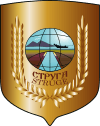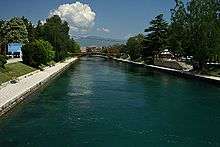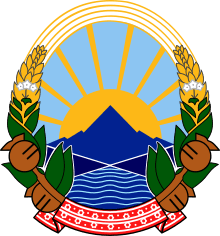Struga
Struga (Macedonian: Струга [ˈstruɡa] (![]()
Struga | |
|---|---|
.jpg) Aerial view of Struga | |
 Coat of arms | |
 Struga Location within North Macedonia | |
| Coordinates: 41°10′N 20°40′E | |
| Country | |
| Region | |
| Municipality | |
| Government | |
| • Mayor | Ramiz Merko |
| Area | |
| • Total | 483 km2 (186 sq mi) |
| Elevation | 693 m (2,273 ft) |
| Population (2002) | |
| • Total | 16,559 |
| Time zone | UTC+1 (CET) |
| • Summer (DST) | UTC+2 (CEST) |
| Postal code | 6330 |
| Area code(s) | +389 46 |
| Car plates | Struga car plate |
| Climate | Cfb |
| Website | www |
Etymology
The origins of the name Struga come from the Old Church Slavonic language.[1] There are three theories regarding the name, all of which are supported by the local inhabitants of the Struga region.
- The first theory is that the name of the town originated from the geographic location of the town. Located at the foot of an open valley and subject to a windy climate, it was suggested that the name originates from the old Macedonian term: струже ветер (it blows wind).
- The second theory says that the name of the city origins from the straga, meaning a cross.
- The third theory comes from the word str'g which means water branch.
The ancient name of the city is Enchalon (Εγχαλών), the ancient Greek word for eel.
History
In the late 19th and early 20th century, Struga was part of the Manastir Vilayet of the Ottoman Empire.
Struga was the birthplace in 1865 Ibrahim Temo, who would go on to be a doctor and one of the founders of the Ottoman reform movement known as the Committee of Union and Progress.[2]
From 1929 to 1941, Struga was part of the Vardar Banovina of the Kingdom of Yugoslavia.
Geography
Struga is located in an open valley on Lake Ohrid. The Black Drin river (Crn Drim) starts at the lake and divides the city.
Demographics
As of the 2002 census, the city of Struga has 16,559 inhabitants and the ethnic composition was the following:[3]
- Macedonians, 8,901 (53.7%)
- Albanians, 5,293 (32.0%)
- Turks, 907 (5.5%)
- Vlachs, 550 (3.3%)
- others, 908 (5.5%)
The mother tongues of the city's residents were the following:
- Macedonian, 9,665 (58.4%)
- Albanian, 5,615 (34.0%)
- Turkish, 823 (5.0%)
- Aromanian, 271 (1.6%)
- others, 185 (1.1%)
The religious composition of the city was the following:
- Orthodox Christians, 9,197 (55.5%)
- Muslims, 7,075 (42.7%)
- others, 287 (1.7%)
| Ethnic group |
census 1948 | census 1953 | census 1961 | census 1971 | census 1981 | census 1994 | census 2002 | |||||||
|---|---|---|---|---|---|---|---|---|---|---|---|---|---|---|
| Number | % | Number | % | Number | % | Number | % | Number | % | Number | % | Number | % | |
| Macedonians | .. | .. | 2,194 | 43.9 | 3,423 | 49.9 | 6,215 | 54.2 | 8,002 | 55.9 | 9,433 | 58.9 | 8,901 | 53.8 |
| Albanians | .. | .. | 1,109 | 22.2 | 1,649 | 24.1 | 3,508 | 30.6 | 4,149 | 29.0 | 4,330 | 27.0 | 5,293 | 32.0 |
| Turks | .. | .. | 927 | 18.6 | 994 | 14.5 | 730 | 6.4 | 832 | 5.8 | 887 | 5.5 | 927 | 5.5 |
| Romani | .. | .. | 141 | 2.82 | 0 | 0.0 | 12 | 0.1 | 421 | 2.9 | 114 | 0.7 | 97 | 0.6 |
| Vlachs | .. | .. | 536 | 10.7 | 0 | 0.0 | 0 | 0.0 | 337 | 2.35 | 462 | 2.9 | 550 | 3.3 |
| Serbs | .. | .. | 42 | 0.9 | 54 | 0.8 | 106 | 0.9 | 84 | 0.6 | 91 | 0.6 | 72 | 0.4 |
| Bosnians | .. | .. | 0 | 0.0 | 0 | 0.0 | 0 | 0.0 | 0 | 0.0 | 0 | 0.0 | 16 | 0.1 |
| Others/undeclared | .. | .. | 47 | 1.0 | 737 | 10.8 | 904 | 7.9 | 500 | 3.5 | 720 | 4.5 | 723 | 4.4 |
| Total | 4,923 | 4,996 | 6,857 | 11,475 | 14,325 | 16,037 | 16,559 | |||||||
Until the last few decades of the 20th century Albanian Tosk, in particular the geographically central variety of the dialect dominated among speakers of Albanian in Struga.[5] The local Romani population of Struga speaks and sings in the southern Tosk Albanian dialect, as does the local Turkish population.[5] Aromanians in Struga also speak Tosk Albanian.
Culture
Struga is also a place of important cultural significance in North Macedonia, as it is the birthplace of the poets Konstantin and Dimitar Miladinov.
The main event of the cultural life in Struga is the world's largest poetry gathering, Struga Poetry Evenings, whose laureates have included several Nobel Prize for Literature winners such as
and many others since 1966.
There are several cultural monuments in Struga and in its vicinity such as
- the Monastery of Kališta, a few kilometers away from the town center, lying on the shore of Lake Ohrid. It is believed that it dates from the 16th century, with frescoes from the 14th and the 15th centuries.
- Another rock church is present in the neighbouring village of Radožda with frescoes from the 13th and 14th centuries.
- The Church of Sveta Bogorodica (St Mary) in Vraništa, is believed to be where Tsar Samuel was crowned.
- The church of St. George is also located in the town; built on top of Samuel's church, it has many icons from the 14th, 15th, and 16th centuries.
- Near the village of Radolishta, a basilica from the 4th century was discovered, with a mosaic.
Struga's old architecture dates from the 18th and 19th centuries.
Sports
Local football clubs FC Struga and FK Karaorman have both played in the Macedonian First Football League. A third club Vllaznimi, currently plays in the Macedonian Third League (Southwest Division).
Economy
Tourism

Much of the town's income is through internal tourism. Struga's location on Lake Ohrid makes it a slightly quieter and more peaceful experience than the more bustling Ohrid.
When visiting this quiet town of North Macedonia, there are a few other places that show the beauty and culture, like the clay chamber pots at the house of the Miladinovci Brothers, the old bazaar, the century old churches and mosques.
Before the evenings you can enjoy on 3 kinds of beaches called "Male beach" (maška plaža), "Female beach" (Ženska plaža) and Galeb ("Gull Beach"), located just before the estuary of the river Crn Drim (Black Drim) in its own flow, and between the two previous beaches.
Just in front of the "Male beach", at the estuary of the river Crn Drim it is located the biggest 5 star Hotel Drim in Struga.
Out of the town there is another tourist place near the lake called Biser (Pearl), also a hotel.
Every August the Struga Poetry Evenings (SPE) are held at the "Poetry Bridge" (Macedonian: Струшки Вечери на Поезијата) and are attended by poets, writers and artists from across the world.
- Churches[6]
- St. George Church - from the 13th century;
- St. Nicholas Church
- Church of the Myrrhbearing Women
International relations
Twin towns – Sister cities
Struga is twinned with:
References
- Macedonia. Bradt Travel Guides. p. 167. Retrieved 2009-10-03.
struga name.
- Temo, İbrahim (1987). İbrahim Temo'nun İttihad ve Terakki Anıları. İstanbul: Arba. p. 5.
- Macedonian census, language and religion Censuses of population 1948 - 2002
- Censuses of population 1948 - 2002 Archived 2013-10-14 at the Wayback Machine
- Murtishi, Kaim (2001). Ladorishti: Histori dhe Tradita. Asdreni. p. 21.CS1 maint: ref=harv (link) "ndërsa për ruajtjen e identitetit të Strugës, flet fakti se në atë qytet, para disa dekadave, flitej vetëm dialekti toskë, sidomos toskërishtja qendrore, ndërmjet Jugut dhe Veriut të Shqiperisë... Këto fakte gjuhësore i vërteton edhe popullata rome, jevgjit e Strugës, flasin dhe këndojnë toskërisht, gjithashtu edhe popullata turke e këtij qyteti, flet dialektin toskë. Këtë dialekt e flasin vllehët e Strugës dhe të Belicës. Këtë dialekt e flet edhe popullata sllave që ka mësuar të flasë shqip."
- Jелена Павловска, Наташа Ниќифоровиќ и Огнен Коцевски (2011). Валентина Божиновска. уред (на македонски). „Карта на верски објекти во Македонија“. Менора - Скопје: Комисија за односи во верските заедници и религиозните групи. ISBN 978-608-65143-2-7
- "Waterbury and Struga Agree To Become Sister Cities, O'Leary To Visit Macedonia Next Summer". The Waterbury Observer. Archived from the original on 2014-01-28. Retrieved 2014-01-23.
External links
- Struga Municipality
- Points of interest in Struga

- Struga Tourism Portal
